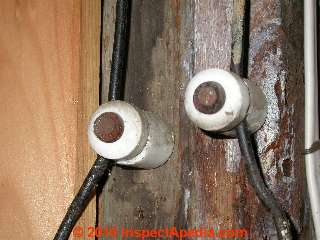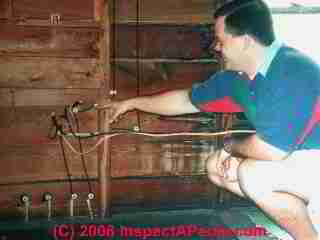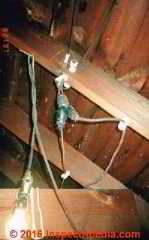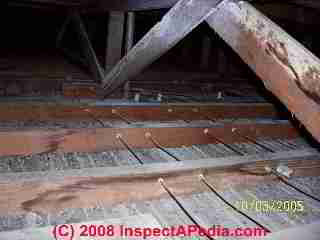 Wet / Submerged Knob & Tube Wiring
Wet / Submerged Knob & Tube Wiring
Inspection, Evaluation, & Repair
- POST a QUESTION or COMMENT about knob and tube wiring: inspection, detection, & repair advice
Fix & Use or Abandon Wet or Submerged Knob & Tube Electrical Wiring
This article discusses the safety and reliability worries when knob and tube electrical wiring has been actually submerged by flooding or when it has been wet by leaks or even moisture rising in a wet or flooded building.
We include opinions on the minimum safe practices where K&T has been wet, and we offer renovation and wiring upgrade suggestions for flooded or wet knob-and-tube-wired buildings. Page top photo: water marks on this joist suggest that even though we see new plywood subfooring (at left in the image) this knob and tube electrical wiring may have been soaked by previous events.
This article series answers most questions about Knob and Tube electrical wiring.
InspectAPedia tolerates no conflicts of interest. We have no relationship with advertisers, products, or services discussed at this website.
- Daniel Friedman, Publisher/Editor/Author - See WHO ARE WE?
Recommendations for Knob & Tube Wiring in Wet or Flooded Buildings

Question: will anyone assure me that it's safe to leave Knob & Tube Wiring In-Use in a Previously-Flooded Home?
In particular, I recently read your section answering the question about submerged wiring, and your response “However, in most instances it is better and safer to replace the wiring." at KNOB & TUBE WIRING FAQs
[Click to enlarge any image]
The International Association of Electrical Inspectors and the National Electrical Manufacturer’s Association appear to be in concert in firmly recommending against the re-use of any electrical wiring that has been submerged in flood waters, unless the wiring has been rated for wet locations.” and “Older wiring such as types with woven cloth insulation are much less resistant to water damage than newer PVC plastic insulated wiring, and should definitely be replaced if subjected to flooding.
Besides a google search for K&T (knob and tube) wiring and water damage or flooding, I also phoned five electrical contractors in New Orleans. They all highly recommended replacing any K&T wiring.
I am half owner of a century old upstairs-downstairs Victorian duplex with knob & tube wiring.
Last August, shortly after the downstairs tenants moved out, the upstairs tenant put laundry in the wash machine, turned on the machine, and left for a vacation. The machine failed to shut off the water. The back halves of both apartments were extensively flooded with probably a thousand gallons of water. The coved ceilings and some walls and some floors in the back half of the lower unit were beyond saving. It was two weeks before the downstairs ceilings were removed.
The ceiling bays contained horsehair padding under the subfloor above that was still dripping water. I could not find anybody then who knew what the horsehair mat was for. It was two more weeks before I decided to remove the horsehair since it was still holding water like a sponge.
A remediation company was hired, but they only dried out the upper unit. The remediation company apparently put multiple machine on one circuit upstairs. When they later moved the dish washer out of the way, they did not completely shut off the hose bib, causing even more water damage down stairs.
When they put their machines down stairs, they again put multiple machines on a single circuit which has not worked properly since.
My worker through it might be a breaker. He replaced the breaker, however that problem remains.
A couple weeks ago, the upstairs tenants asked for a rent reduction, primarily based on noise complaints, but they also included the fact that they now have intermittent electrical problems since the flood. This now raises the possibility of adding damage to the electrical system to the insurance loss claim.
Except for kitchen and main panel upgrades, and adding lines for clothes washer and electric wall heater, the K&T appears to be in early 1920’s “as built” condition.
When the coved ceilings gets replaced, it will be with a double layer suspended sheetrock ceiling with semi-flexible perimeter coving for impact sound isolation that hopefully will not need to be touched for another century. This will also entail filling the joist bays with fiberglass insulation for sound absorption. Any later electrical work in the ceiling would be difficult and very expensive.
The K&T wire here was not submerged, but it was definitely water saturated or near saturated for over a month. It was five or six months later before the apartment felt normally dry. Some links referred to water causing possible dry rot damage to the linen or cotton fibers in the K&T cambric covering.
My understanding is that dry rot is a fungus that needs organic material, moisture and air, and cannot grow in submerged conditions.
Everyone seems to agree that modern wiring should last and be trouble free for the next century. However, I have been unable to find a local electrician who will take a position that the current wiring is either unequivocally reliable after perhaps some trouble shooting and correction, or is sufficiently questionable and unreliable and should be replaced.
Assuming the information provided above is accurate, what would you recommend? Does the saturated K&T wiring above fall into a category similar to submerged or flooded requiring replacement? Or is there some test that could be done to determine such. - Anon by private email, 2017/03/25
Reply: turn off bad circuits, add new circuits, check for hidden damage & mold
 Your question is an important one that bears some thought and comments in the form of OPINION.
Your question is an important one that bears some thought and comments in the form of OPINION.
Our photo shows improperly-extended knob and tube wiring in an attic as well as leak stains on the roof decking: was this knob and tube wiring ever wet? Was it damaged?
First: regarding your remark about observing " ... intermittent electrical problems since the flood."
That's very worrisome, since there are risks of both fire and shock when an electrical system is in troubl
e. Wet insulation or building materials can short wiring, for example. I know this may seem chicken-hearted, but if it were my house I would TURN OFF any misbehaving circuit right away until it could be traced, examined, repaired.
That's inconvenient for your price-haggling tenants but you might get away with a heavy duty extension cord for a time - (not under rugs etc or you'll create another fire hazard).
Of course the original wiring that kept hot and neutral apart, in air, with ceramic knobs and tubes preventing contact with wood or other combustible surfaces made this a nice wiring method, and of course most people understand by now that the absence of a ground conductor means the circuit can never be as safe as a newer grounded electrical circuit.
There are multiple risks with older K&T wiring, of which you've noted the experts warning about wetting the wire insulation and thus damaging it.
What's often not mentioned, although we do beginning at KNOB & TUBE WIRING are additional risks where knob and tube wiring (K&T) remain in use:
Safety & Reliability Concerns about Continued Use of Existing K&T also Arise Because
Our photo shows old knob and tube wiring as it was originally installed in an attic floor: note that the wiring runs in open air, not covered by nor buried in insulation.
- We don't know the condition of wiring in hidden cavities of walls, floors, ceilings
- The addition of insulation in buildings, for example blowing in foam or cellulose or pouring in vermiculite, completely changes the fire-rating and safety of the original wire insulation that was intended to be hung in open air. So we've already down-rated the wires.
- We don't know who was gnawing on wires in hidden areas - some squirrels and rats really seem to love chewing on wire insulation
- We hope that nobody has extended the older K&T circuits (which is not permitted) as occupants want more receptacles, switches, lights.
- We don't know what previous leaks and wetting events, before the terrible New Orleans floods and storms washed away my grandparents from the cemetery where they were buried at the Hope Mausoleum in New Orleans (Grandpa Henry Germann & Grandma Hannah Denekamp).
Dealing with the Mold Risks in a Flooded or Wet Home
I'd be concerned too about hidden mold contamination. You are not exactly right when focusing on the statement "dry rot ... cannot grow in submerged conditions"
Do Not Do Expensive Interior Surface Improvements (Walls, Ceilings) Before Investigating & / Or Doing Wiring & Plumbing Work
I would absolutely NOT layer on more coverings on any wall or ceiling before first making a test cut opening or two in the most-suspect areas to double check that there's not damaged or moldy drywall (plaster is more mold resistant but not mold proof) moldy insulation, mold on wood framing, or rot or insect damage. It'd be hell to laminate more drywall then to have to tear it off to repair the building.
I would also NOT layer on more drywall before deciding if I needed to add electrical circuits, or to replace or abandon existing knob and tube circuits, for the same reasons; It's much nicer, and less expensive, when snaking new wires, to be able to make cuts wherever you need, knowing that the wall or ceiling will be covered over with more drywall later.
Why Electricians Say Replace Everything
You'll have a hard time finding someone stupid enough to guarantee the safety of an old electrical circuit that they didn't install, know nothing about, and cannot see - or you'll find some dope, probably a smalltime contractor with no insurance, who might live on the edge and promise you more than a more-informed electrician would dare.
You'll also face the OTHER PEOPLE'S MONEY problem that contractors will take the safe path - which means spending more of your money to reduce their risk of a future complaint or lawsuit.
So spending your money on my worry: I would be reluctant to laminate more drywall and thus face that cost, before abandoning any and all questionable circuits; and I would add all new circuits (see my notes below) first too. Your comments make plain you know this so I'm really emphasizing it for other readers.
It's cheaper to do wiring first, as I noted. And it is likely that an older home needs more circuits anyway.
Minimum Smart Wiring Changes / Additions in a Wet or Flooded Home
OK so if you figure for you it's not OPM its MM (my money) and you are still troubled by the circuit abandoning prospect, I would at a minimum do this:
- Turn off any misbehaving electrical circuits immediately, and don't bet that just with more drying time those circuits become magically "safe" - they don't. In addition to insulation deterioration there's a worry of corrosion at electrical connections and devices
- Abandon those bad K&T circuits during renovations - permanently cutting off power at the source and labeling the old wires so future owners will know what the hell they were or where they went - as people will find the other end here and there
I like to actually tie together the hot and neutral at the other end (point of use) of abandoned circuits so that when my friend Jim H., who likes to re-use old circuits tries to hook one of them up it will immediately trip the breaker or blow the fuse - telling us NO NO NO JIM! (Jim, a renovator of an old Poughkeepsie home does not agree). - Add additional electrical circuits where needed - both for convenience and safety:
-- 2 20A circuits in kitchens
-- GFCI protected grounded circuits for baths, kitchens, garage, basement, etc. as required by standards
-- dedicated circuits for high-amp uses: washer, refrigerator, etc.
-- rooms served only by existing K&T circuits that may later have to be abandoned - Label the remaining in-use K&T circuits: Where you thus left in use old knob and tube circuits, you will have labeled which they are at the panel so that if those show any trouble signs they can be turned of.
And you will have of course added one or more new circuits to each of those areas so you're not leaving those parts of the home without adequate electrical service for the next 100 years (or less depending on how fast the sea rises around Nawlins) - Install proper receptacles: Be sure that ALL of the K&T circuit receptacles left in use are the proper type - 2-slot without a ground opening - so that users know they're on an un-grounded circuit
- Make test openings in most-suspect areas to inspect for hidden water-trouble as I cited above.
Keep in mind that in a flooded building there will be serious electrical or other damage and can be serious mold damage even in areas that were never under water.
While the home was wet moisture will have moved upwards throughout the building and is often trapped long-enough in upper floor walls, ceilings, floors, attic or roof spaces to condense and to make trouble: electrical component corrosion or mold, for example.
These articles should also be helpful to you:
- CORROSION & MOISTURE SOURCES in PANELS
- ELECTRICAL SAFETY for FLOOD DAMAGE INSPECTORS
- ELECTRIC POWER LOSS / FLICKERING LIGHTS
- FLOOD REPAIR PRIORITY STEPS
...
Continue reading at KNOB & TUBE WIRING - topic home, or select a topic from the closely-related articles below, or see the complete ARTICLE INDEX.
Or see these
Recommended Articles
- KNOB & TUBE WIRING of Proper and Improper Knob and Tube Wiring Details
- KNOB & TUBE WIRING FAQs
- WET SUBMERGED K&T WIRING
Suggested citation for this web page
WET SUBMERGED K&T WIRING at InspectApedia.com - online encyclopedia of building & environmental inspection, testing, diagnosis, repair, & problem prevention advice.
Or see this
INDEX to RELATED ARTICLES: ARTICLE INDEX to ELECTRICAL INSPECTION & TESTING
Or use the SEARCH BOX found below to Ask a Question or Search InspectApedia
Ask a Question or Search InspectApedia
Questions & answers or comments about knob and tube wiring: inspection, detection, & repair advice.
Try the search box just below, or if you prefer, post a question or comment in the Comments box below and we will respond promptly.
Search the InspectApedia website
Note: appearance of your Comment below may be delayed: if your comment contains an image, photograph, web link, or text that looks to the software as if it might be a web link, your posting will appear after it has been approved by a moderator. Apologies for the delay.
Only one image can be added per comment but you can post as many comments, and therefore images, as you like.
You will not receive a notification when a response to your question has been posted.
Please bookmark this page to make it easy for you to check back for our response.
IF above you see "Comment Form is loading comments..." then COMMENT BOX - countable.ca / bawkbox.com IS NOT WORKING.
In any case you are welcome to send an email directly to us at InspectApedia.com at editor@inspectApedia.com
We'll reply to you directly. Please help us help you by noting, in your email, the URL of the InspectApedia page where you wanted to comment.
Citations & References
In addition to any citations in the article above, a full list is available on request.
- [2] Timothy Hemm, Yucala, CA, contributed various photographs of electrical equipment installed in California buildings. Mr. Hemm can be contacted at TimHemm@yahoo.com
- [3] Kosta Trivlidis Home Inspector (AIBQ) National Home Inspector (NHICC) CSI Inspections Inc. csiinspections.ca kosta@csiinspections.ca
- "Electrical System Inspection Basics," Richard C. Wolcott, ASHI 8th Annual Education Conference, Boston 1985.
- "Simplified Electrical Wiring," Sears, Roebuck and Co., 15705 (F5428) Rev. 4-77 1977 [Lots of sketches of older-type service panels.]
- "How to plan and install electric wiring for homes, farms, garages, shops," Montgomery Ward Co., 83-850.
- "Simplified Electrical Wiring," Sears, Roebuck and Co., 15705 (F5428) Rev. 4-77 1977 [Lots of sketches of older-type service panels.]
- "Home Wiring Inspection," Roswell W. Ard, Rodale's New Shelter, July/August, 1985 p. 35-40.
- "Evaluating Wiring in Older Minnesota Homes," Agricultural Extension Service, University of Minnesota, St. Paul, Minnesota 55108.
- "Electrical Systems," A Training Manual for Home Inspectors, Alfred L. Alk, American Society of Home Inspectors (ASHI), 1987, available from ASHI. [DF NOTE: I do NOT recommend this obsolete publication, though it was cited in the original Journal article as it contains unsafe inaccuracies]
- "Basic Housing Inspection," US DHEW, S352.75 U48, p.144, out of print, but is available in most state libraries.
- In addition to citations & references found in this article, see the research citations given at the end of the related articles found at our suggested
CONTINUE READING or RECOMMENDED ARTICLES.
- Carson, Dunlop & Associates Ltd., 120 Carlton Street Suite 407, Toronto ON M5A 4K2. Tel: (416) 964-9415 1-800-268-7070 Email: info@carsondunlop.com. Alan Carson is a past president of ASHI, the American Society of Home Inspectors.
Thanks to Alan Carson and Bob Dunlop, for permission for InspectAPedia to use text excerpts from The HOME REFERENCE BOOK - the Encyclopedia of Homes and to use illustrations from The ILLUSTRATED HOME .
Carson Dunlop Associates provides extensive home inspection education and report writing material. In gratitude we provide links to tsome Carson Dunlop Associates products and services.


